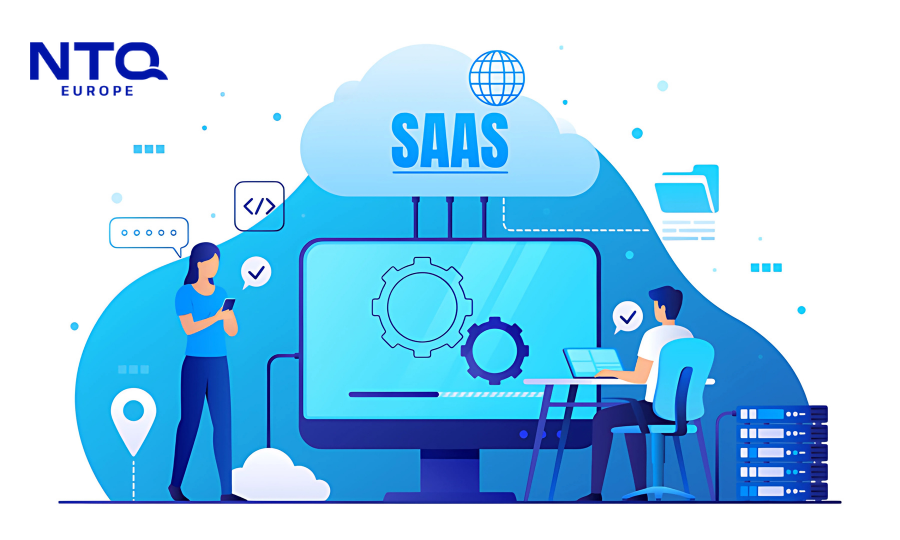1. Introduction to Cloud Managed Services
Cloud-managed services allow businesses to run, scale, and secure cloud infrastructure with full-stack management while optimizing costs and enhancing performance in their digital transformation journey.
What Is Cloud-Managed Service?
Cloud Managed Services offer technical support from a third-party cloud management provider to maintain and enhance a business’s cloud infrastructure, applications, and operations.
These services include cloud assets and infrastructure monitoring, performance optimization, security management, cost control, and compliance.
Instead of managing everything in-house, businesses rely on cloud experts to maintain their environments secure, efficient, and scalable.
Key benefits of Cloud Managed Services
As more businesses move toward hybrid and multi-cloud strategies, cloud managed services become an essential component of IT modernization.
Managed cloud services allow your businesses to concentrate on their core competencies while minimizing operational overhead and leveraging cutting-edge technologies.
When businesses have access to 24/7 support and continuous system monitoring, they’re better equipped to stay secure, innovate faster, and maintain consistently high performance.

Cloud Managed Services vs. In-House Cloud Management
Choosing between in-house cloud management and outsourcing cloud-managed services is a strategic decision affecting operational efficiency, costs, and scalability.
|
Criteria |
Cloud Managed Services |
In-House Cloud Management |
|
Initial Investment |
Pay-as-you-go model with minimal upfront costs for infrastructure or personnel |
Significant investment in internal staff and IT infrastructure |
|
Operational Costs |
Predictable and optimized based on actual usage |
High and often increasing due to staffing, training, and maintenance needs |
|
System Control |
Delivered by cloud experts |
Complete control over configurations and operations |
|
Scalability |
Highly flexible, scale resources up or down easily with ongoing support |
Limited, depending on internal capacity and infrastructure constraints |
|
Access to Expertise |
Immediate access to certified professionals across cloud technologies |
Relies on the skills and experience of in-house IT teams |
|
Technology Updates |
Rapid adoption – Providers stay current with the latest tools and best practices |
Slower – Dependent on budget and internal upgrade cycles |
|
Security & Compliance |
Built-in solutions that adhere to global standards, such as ISO, GDPR,… |
Require in-house development and monitoring of security and compliance measures |
|
Response Time |
24/7 monitoring and support with better SLA-backed performance |
Slower during off-hours, depending on internal availability |
|
Focus on Core Business |
Free internal teams to focus on innovation and strategic initiatives |
More time spent on daily IT operations and troubleshooting |
Cloud Managed vs. On-Premise IT Management
Understanding the differences between cloud managed and on-premise IT management will help you make an informed decision, aligning with your business’s objectives and operational needs.
On-premise IT Management involves hosting and maintaining IT infrastructure on-site, which can limit flexibility and scalability.
In contrast, cloud managed services shift the paradigm by offering real-time resource scaling, integrated security measures, and cost transparency.
2. Challenges of In-House Cloud Management
For businesses without available resources or in-depth experience, attempting to manage cloud systems on their own can become challenging and time-consuming.
High Maintenance Costs
One of the biggest challenges of in-house management is the increasing maintenance costs. Operating an in-house system requires ongoing investment in highly skilled cloud specialists, regular technical training, hardware maintenance, and the purchase of cloud monitoring and security tools. This makes cost management a major barrier in the long-term sustainability of internal cloud operations, particularly for SMEs with limited budgets.
For small and medium-sized businesses, this can become a major barrier to maintaining operational efficiency and competitiveness.
Lack of Cloud Expertise
Cloud management requires in-depth knowledge of cloud architecture, security, automation, and the ability to integrate with existing systems while in-house IT teams may lack specialized expertise and practical experience in cloud platforms such as AWS, Azure or Google Cloud. In addition, recruiting or training a team of cloud experts is also time-consuming and costly. This can result in inefficient use of resources, risk of data security, misconfigurations, and technical debt.
Security and Compliance Risks
Improper cloud setup can expose businesses to major risks such as data breaches, non-compliance with industry standards like GDPR or ISO/IEC 27001, mismanaged access control or identity management
This is the reason why more and more businesses are choosing cloud managed services from professional partners to ensure that security and compliance measures are built in from the start and maintained continuously throughout the entire system development lifecycle.
System Performance Instability
Businesses face system delays, latency issues, traffic congestion, or unexpected downtime during peak usage. These issues can disrupt regular operations while negatively affecting users experience.
To maintain stability and optimize performance, businesses need a comprehensive management and monitoring system, along with a dedicated team of experts to adjust, optimize resources and handle incidents quickly.
3. Cloud Managed Service Models
Infrastructure Management
- High availability
- Optimal load distribution
- Automated incident resolution
- Application Management
- Properly deployed
- Continuously updated
- Monitored for performance and errors
Security & Compliance Management
- Threat detection and prevention
- Identity & access management (IAM)
- Data encryption and privacy controls
- Regulatory compliance enforcement (e.g., GDPR, HIPAA)
Cost Optimization
- Avoid overprovisioning
- Reduce waste
- Align spend with actual usage
Backup & Disaster Recovery
4. Cloud Managed Service Process
Successfully leveraging cloud managed services involves a structured approach:
Assessment & Planning
The cloud expert will work with the business to understand the current IT infrastructure status and assess the system’s readiness for cloud migration then develop a clear strategy to align cloud capabilities with business objectives.
Implementation & Integration
Providers configure cloud environments, migrate workloads if necessary, and integrate third-party tools and services. This phase includes CI/CD pipeline setup, DevOps tool integration and security policy implementation.
Monitoring & Maintenance
Ongoing monitoring ensures:
- System availability
- Performance metrics tracking
- Early detection of anomalies
Automated alerts and predictive maintenance further reduce downtime and improve user experience.
Optimization & Upgrades
Providers regularly monitor operation, proactively update patches, adjust resource allocation while continuously integrating new features to improve operational efficiency and keep the cloud infrastructure stable, aligning with evolving business requirement.
5. Benefits of Cloud Managed Services for Businesses
In the digital transformation journey, businesses are looking for scalable and cost-effective solutions to maintain their competitive advantage. Effective cloud infrastructure management is no longer an option, but has become a key factor in sustainable development strategies. Below are the outstanding benefits that businesses can achieve when applying this model.
Reduced IT Operational Costs
One of the most appealing advantages is the reduction in IT operational expenses. Partnering with a provider of managed cloud services allows your business to avoid the cost of recruiting, training, and retaining in-house cloud specialists while eliminating capital expenses for hardware and software. At the same time, your business also benefit from economies of scale and shared infrastructure.
Improved System Performance and Uptime
Cloud managed providers offer round-the-clock monitoring, predictive analytics, and performance tuning, ensuring faster response times, reduced downtime and proactive issue resolution.
With tools like autoscaling and load balancing in place, businesses can maintain consistent performance, even during peak demand periods.
Enhanced Data Security and Compliance
Modern cloud managed services include built-in data protection strategies such as encryption at rest and in transit, role-based access controls, intrusion detection systems, and regular audits and compliance reporting.
These security features significantly lower the risk of cyberattacks or data leaks, while also ensuring compliance with standards like GDPR, ISO, or SOC 2.
Greater Flexibility and Scalability
Business needs evolve rapidly. Whether you’re entering a new market, launching a new product, or managing seasonal spikes in demand, managed services and cloud platforms offer seamless scalability. Resources can be adjusted instantly, without service interruptions, allowing for:
- Faster time to market
- Agile development workflows
- Effortless geographic expansion
6. How to Choose the Right Cloud Managed Services Provider
To select a trusted cloud managed service partner, you should consider these key factors as follows:
Evaluation Criteria
When vetting providers, consider the following:
- Experience and certifications: Look for proven expertise in your preferred platforms (AWS, Azure, Google Cloud)
- Customization capabilities: One-size-fits-all doesn’t work—services should be tailored to your unique needs
- Service portfolio: Ensure the provider offers complete coverage, including infrastructure, application, and cloud application lifecycle management
- Importance of SLA (Service Level Agreement)
The SLA defines the service scope, responsibilities, response times, and penalties for downtime or underperformance. A well-crafted SLA is non-negotiable, it:
- Provides accountability
- Sets clear expectations
- Protects your investment
Review SLA metrics such as uptime guarantees, response and resolution times, and data recovery objectives.
Trends to Watch: AI-Driven and Multi-Cloud Strategies
Modern cloud management is increasingly driven by AI technology. With the ability to predict technical problems and automate security alerts, AI not only optimize performance but also contributes to minimizing operational risks.
Additionally, adopting a multi-cloud strategy – distributing workloads across different cloud vendors – leads to reduced vendor lock-in, optimized pricing models, and improved resiliency.
Therefore, you should partner with a provider with a proven track record in multi-cloud architecture management and AI integration.
7. Cloud Managed Services Solutions by NTQ Europe
At NTQ Europe, we understand the unique challenges European businesses face in managing and scaling cloud operations. Our cloud services offering is designed to be secure, scalable, and smart.

Comprehensive Cloud Management Approach
- Infrastructure Management: Ensuring high availability and optimal performance
- Application Maintenance: Managing custom-built and third-party cloud applications
- Security and Compliance: Adhering to EU data regulations and global standards
- Cost Monitoring: Offering visibility and control over cloud spend
AI and Automation at the Core
- Detect anomalies before they cause issues
- Forecast resource needs
- Automate backups and scaling
- Provide 24/7 intelligent support
Multi-Cloud Expertise
- Amazon Web Services (AWS)
- Microsoft Azure
- Google Cloud Platform (GCP)



















